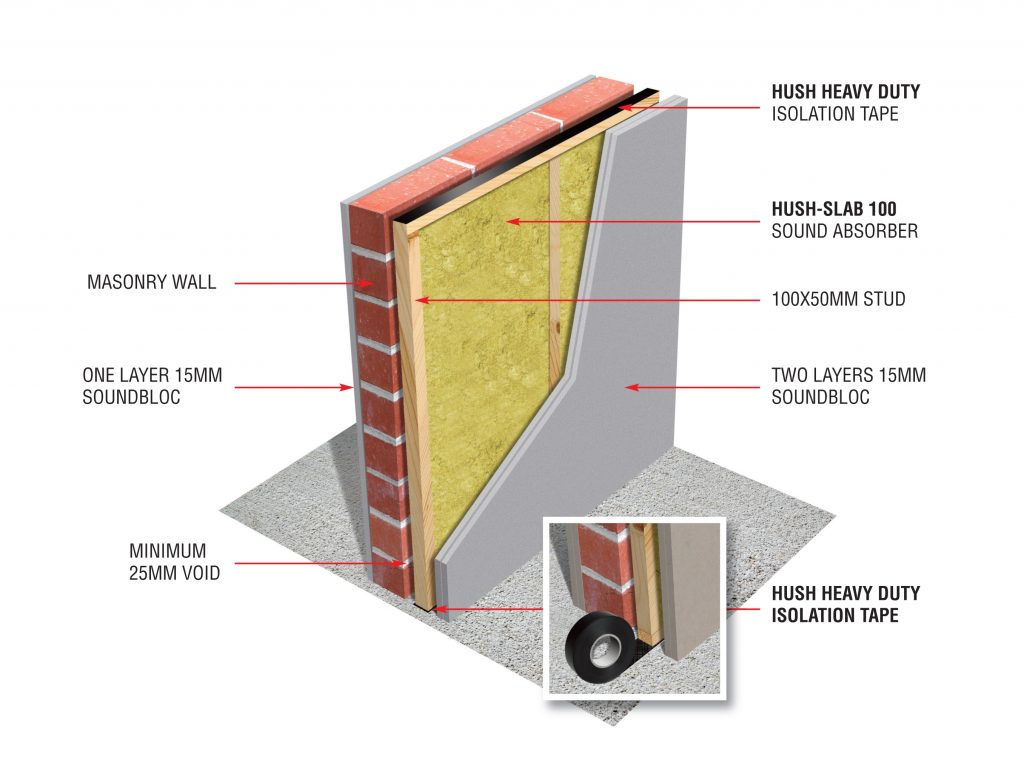
Hush: What are the acoustic design requirements for HMOs?
This article from Hush Acoustics explores exactly what are the acoustic design requirements for Houses in Multiple Occupancy (HMOs)?
It is estimated there are nearly 490,000 Houses in Multiple Occupancy (HMOs) across England alone, with many more in Scotland, Wales and Northern Ireland. And although there may be some ambiguity around what defines an HMO, it is clear that this type of accommodation accounts for a significant part of the UK’s housing stock.
An HMO, in general terms will have at least three tenants living in it, forming more than one household and the toilet, bathroom or kitchen facilities will be shared between tenants. One property/building, therefore, becomes home to multiple people, often students, but increasingly professionals who may be unable to rent a property of their own due to the high cost or because they prefer a more sociable living arrangement.
This lack of exact definition and differences in interpretation by Building Control officers across the UK can make it difficult to know whether minimum acoustic performance standards apply or not. However, best practice should always be to ensure that the walls and floors that separate bedrooms and/or bathrooms and other parts of the property provide sufficient sound insulation.
It may seem most straightforward to design the separating walls, floors and ceilings of an HMO in line with the feedback from your local Building Control officer, which may or may not be aligned with the minimum standards set for connected stand-alone properties.
Terraced or semi-detached houses and apartments, for example, will have to be built with separating walls and floors that meet the requirements of Approved Document E of the Building Regulations in England & Wales, Section 5 of the Technical Standards in Scotland and Part G in Northern Ireland. But these standards may not always be stipulated for an HMO – rightly or wrongly.
The financial benefits of good acoustic design
Consider the bigger picture, however, and it makes sense to design all HMOs to a high acoustic standard regardless of the interpretation on specific projects. Get the design right and internal comfort to a high standard and tenant churn will be lower and the reputation of the HMO will be better, leading to shorter let times.
While location is always regarded as key when investing in an HMO, it is important that the property will be most popular with tenants when individual rooms are quiet enough to allow for a good night’s sleep, work or study – and these will only be delivered when noise from communal areas or other rooms is limited. Hence why focusing on ensuring the wall and floor design offers sufficient sound reduction properties will pay dividends!
Creating an HMO to a high standard, which of course includes sound control levels beyond mere compliance, can therefore enable the property to retain a high level of occupancy and more satisfied tenants.
Demonstrating acoustic compliance
How do you know if the acoustic performance you are seeking in the HMO will actually be achieved? Firstly, it is important to work with an acoustic insulation specialist with knowledge of how to address the many possible sound transmission paths between rooms, particularly in refurbishment or conversion projects.
Early design consultation with Hush Acoustics will enable your design to be refined to avoid the risk of costly remediation work further down the line.
This is important because, whether you are the builder or owner of an HMO, if Building Control or local planners stipulate it, you are legally required to meet the current sound testing regulations through a correctly conducted test before marketing the space to potential buyers or tenants.
A sound test is, therefore, required on completion of the building or conversion work as this demonstrates how well the building handles sound and if the levels of noise that pass through walls and doors fall within an acceptable and legal level. Building Regulations approval will only be granted when evidence of a successful pass is presented following the sound test, so it is important to have the test requirements in mind from day one.
How to avoid the acoustic risks in HMOs
The vagueness of the Building Regulations in respect of acoustic performance in HMOs, and the fact that every building will be constructed in a slightly different way, may make it difficult to know how to get your design right.
But with the support of the Hush Acoustics team, who have been specialising in building acoustics for more than 30 years, the most common pitfalls can be avoided and detail elements that make a massive difference will be correctly addressed before construction work starts.

Hush Acoustics manufactures a wide range of acoustic insulation products, including Hush Panel 28, the UK’s most specified acoustic flooring panel, and Hush Slab 100, a high quality insulation slab for cavities and voids between walls and floors.
These products are combined into fully tested acoustic systems from Hush, which can be used to treat timber, concrete/masonry and metal separating floors/ceilings and walls with confidence.
To find out more, visit www.hushacoustics.co.uk.
Hush Acoustics Ltd
Unit 2, Tinsley Industrial Estate
Shepcote Way
Sheffield
South Yorkshire
S9 1TH
Tel: 0114 551 8685
Fax: 0151 944 1146
Visit Supplier's page
Latest news

23rd April 2024
Trio of Senior products used in new Nottingham residential scheme
Solutions from Senior Architectural Systems have helped complete The Barnum – a new residential development on Nottingham’s Queen’s Road.
Posted in Aluminium Products, Articles, Building Industry News, Building Products & Structures, Building Systems, Case Studies, Curtain Walling, Doors, Glass, Glazing, Posts, Restoration & Refurbishment, Retrofit & Renovation, Walls, Windows
22nd April 2024
New EJOT role will develop strategic support for UK flat roofing sector
EJOT UK has taken a major step in the expansion of its support for the flat roofing market by appointing one of its most experienced building envelope fastening specialists as its first sector-dedicated business development manager.
Posted in Articles, Building Industry News, Building Products & Structures, Building Systems, Innovations & New Products, Posts, Recruitment, Restoration & Refurbishment, Retrofit & Renovation, Roofs
22nd April 2024
Access2 Wins ADSA-Sponsored Award at AI Specification Awards
Access2 clinched the ADSA-sponsored Product Design and Innovation Award (Electronic) at the AI Specification Awards 2024 on Thursday.
Posted in Access Control & Door Entry Systems, Architectural Ironmongery, Articles, Awards, Building Associations & Institutes, Building Industry Events, Building Industry News, Building Products & Structures, Building Services, Doors, Facility Management & Building Services, Information Technology, Innovations & New Products, Retrofit & Renovation, Security and Fire Protection, Video of the Week
19th April 2024
ASSA ABLOY: Access solutions can impact sustainability performance across the full life-cycle of a building
Embedding sustainability within any organisation requires a broad, strategic perspective. Scrutiny should include the physical infrastructure itself: According to the IEA, buildings consume around 30% of global energy*. ASSA ABLOY has more…
Posted in Access Control & Door Entry Systems, Architectural Ironmongery, Articles, Building Industry News, Building Products & Structures, Building Regulations & Accreditations, Building Services, Case Studies, Doors, Facility Management & Building Services, Information Technology, Research & Materials Testing, Retrofit & Renovation, Security and Fire Protection, Sustainability & Energy Efficiency, Video of the Week
 Sign up:
Sign up: